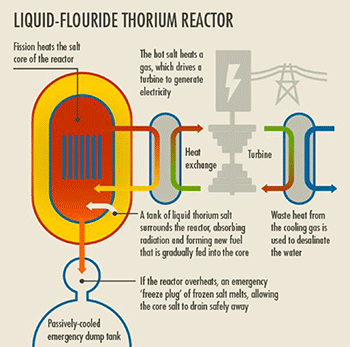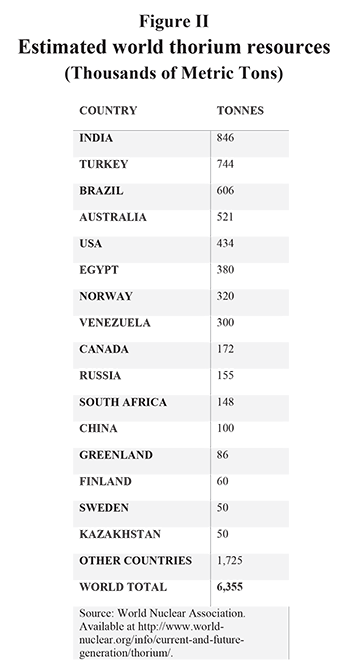Nuclear energy promised to generate low-cost electricity safely, with fewer environmental and health problems from air and water pollution than fossil-fueled power plants. For a number of reasons, that promise has not been fulfilled.
However, in addition to new designs for uranium-fueled reactors, efforts are underway in a number of countries to develop commercial nuclear reactor designs that could solve many of the problems encountered with existing uranium-fueled nuclear power plants. This new generation of reactors will be fueled by thorium (Th-232) instead of uranium (U-235).
Thorium is found mixed in with some commercially recoverable rare earths (RE) deposits, including some in the United States. Because thorium is not generally used for energy production, it is usually not recovered from RE ores. Furthermore, because thorium is slightly radioactive, its presence in ore is a production problem for some RE deposits. Over the next few years, this could change if electricity-generating thorium reactors come on line. The increased demand for thorium could potentially turn it into an additional revenue stream for U.S. domestic RE mining operations.

Experimental Thorium Reactors. In the 1940s, American nuclear scientists studied the use of thorium as an energy source for nuclear reactors. However, because the United States and Soviet Union were engaged in the Cold War after the Second World War, thorium’s advantages were overwhelmed by its inability to produce plutonium, an element used in atomic bombs. Uranium-fueled reactors, by contrast, produce plutonium. Thus, the nuclear powers preferred to develop the type of nuclear reactors in use today.
However, in the 1960s, the Oak Ridge National Laboratory built and operated an experimental thorium-fueled reactor, demonstrating its feasibility.
How Thorium and Uranium Reactors Work. The main types of uranium-fueled reactors currently in use transfer heat from a nuclear pile of uranium fuel rods to pressured water. The water is pressurized to increase the efficiency of the heat transfer; however, high pressure requires expensive systems to prevent and contain leaks. The water itself becomes radioactive; hence the potential for radioactive leaks into the atmosphere.
Thorium reactors use a liquid chemical compound, thorium fluoride, as both a heat source and a circulating liquid that transfers heat to a gas, which is used to drive turbines that generate electricity. Thus, this type of reactor is called a molten salt or liquid fluoride reactor. Thorium, in contrast to uranium, is not itself fissile. But, if bombarded by neutrons from a uranium or plutonium core, thorium is transmuted into U-233, which heats the liquid. Because the boiling point of thorium fluoride is much higher than the temperature at which the reactor operates, the circulating fluid is unpressurized and much less containment infrastructure is required. In the generator, thermal energy is converted into electricity, as shown in Figure I.
Advantages of Thorium-Fueled Reactors. Over the past decade, given the global competition for energy and the increasingly fierce and unstable global security situation, scientists started to reinvestigate the possibility of using thorium as fuel for nuclear power. Thorium-fueled reactors have a number of advantages over uranium reactors, including less potential for nuclear proliferation and less waste. In addition:
- Thorium is three times as abundant in the Earth’s crust as uranium, and there are thorium-bearing ores identified in many countries [see Figure II].1
- Currently operating nuclear reactors are inefficient in extracting energy from uranium. Only about 3 percent of the uranium in the rods is consumed before the rods must be replaced, due to the build up of fission byproducts in the rods.
- Fission byproducts in liquid thorium salts, by contrast, can be removed and reprocessed to produce additional fuel stock, while the reactor continues to operate.

Thorium-based reactors have been shown to be more economical than uranium-fueled reactors.2 In contrast to conventional light water reactors using uranium, according to a 2013 report from the Bellona Foundation:3
- The capital costs of thorium reactors would be lower than conventional nuclear reactors; a 1 gigawatt (GW) thorium power plant would cost at most an estimated $780 million in comparison to capital costs currently of $1.1 billion per GW for a uranium-fueled reactor.
- Less manpower would be required to operate the plant; for a 1 GW power plant, staffing costs may decrease from $50 million to $5 million.
- Less radioactive waste is produced, perhaps one-tenth as little, by volume; thus, nuclear waste disposal for a 1 GW thorium power plant would cost an estimated $1 million or even less per year.
As a result of lower capital costs, fuel costs and waste disposal costs, thorium-generated electricity costs could be lower than electricity produced from natural gas or coal. Comparing a rough estimate of the potential cost of electricity from thorium with average prices for other forms of generation, in 2002:4
- The real cost of electricity generated by U.S. nuclear power plants was 6.7 cents per kilowatt hour (kwh).
- Electricity from plants burning pulverized coal cost 4.2 cents/kwh to produce.
- Electric power from moderately priced natural gas cost 4.1 cents/kwh.
- Power from a thorium reactor would cost, by comparison, cost an estimated 1.4 cents/kwh.
Thus, thorium has the potential to reduce retail electricity prices significantly.5
Thorium Projects in Developing Countries. There are some efforts underway to design and build thorium reactors in developed countries, such as Japan and Russia, but the main efforts are in emerging economies.
India. With unrivaled thorium reserves, India has been implementing a highly ambitious thorium plan and designed a successor to the early thorium-based nuclear reactor built at Oak Ridge National Laboratory in the 1960s. India plans for thorium-based power to eventually supply around 30 percent of the country’s electricity by 2050, whereas nuclear power plants currently produce a mere 3 percent of the country’s electricity.
China. Widely acknowledged as an energy-consuming country, China has encountered a severe energy shortage. In 2005, China’s gross domestic product was $2.25 trillion.6 China’s GDP is expected to reach $20 trillion by 2040. Therefore, China is eager to find any natural resource they can get for sustainable economic development, which makes its thorium plan even more ambitious. The Chinese National Academy of Science has launched a $350 million project to build a fully-functioning thorium plant within 10 years, and aims to eventually replace most coal-powered plants in China.7
The plan, led by Jiang Mianheng, son of former President Jiang Zemin, will involve 140 scientists at the Shanghai Institute of Nuclear and Applied Physics and up to 750 scientists by 2015. The plan also projects the generation of almost 40 GW of electric power from thorium by 2020, and 260 GW by 2050. By contrast, in 2011, 78.95 percent of China’s electric power came from coal, 14.82 percent from hydroelectric, 1.78 percent from natural gas and 1.83 percent from nuclear.
Conclusion. There are technical challenges in designing an efficient thorium-fueled nuclear reactor, but current development efforts underway will likely lead to a commercially practical system. The relative abundance, greater safety and lower cost of thorium-fueled systems could help fulfill the promise of nuclear power.
Xinyuan Zou is a research associate and Joe Barnett is senior director of policy research at the National Center for Policy Analysis.
Endnotes
1 “Thorium,” World Nuclear Association, September 2014. Available at http://www.world-nuclear.org/info/current-and-future-generation/thorium/.
2 Sherman Lam, “Economics of Thorium and Uranium Reactors,” Harvey Mudd College, unpublished paper, page 10. Available at http://www2.hmc.edu/~evans/LamThorium.pdf.
3 Leonid Andreev, “Certain Issues of Economic Prospects of Thorium-based Nuclear Energy Systems,” Bellona Report, 2013,page16. Available at http://bellona.org/assets/sites/6/Certain-issues-of-economic-prospects-of-thorium-based-nuclear-energy-systems.pdf.
4 Stephen Ansolabehere, MIT Study on the Future of Nuclear Power, Massachusetts Institute of Technology, 2003, available at http://web.mit.edu/nuclearpower/pdf/nuclearpower-full.pdf; and Sherman Lam, “Economics of Thorium and Uranium Reactors.”
5 By 2007, nuclear power costs rose to 8.4 cents per kwh, coal to 6.2 cents, and natural gas to 6.5 cents. John M. Deutch, “Update of the MIT 2003 Future of Nuclear Power Study,” Massachusetts Institute of Technology, 2009. Available at http://web.mit.edu/nuclearpower/pdf/nuclearpower-update2009.pdf.
6 World Bank, 2005.
7 Ari Phillips, “China’s Plan to Develop Totally New Nuclear Fuel Speeds up,” Climate Progress, March 20, 2010. Available at http://thinkprogress.org/climate/2014/03/20/3416936/chinas-nuclear-thorium-development/.